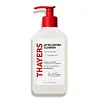What's inside
What's inside
 Key Ingredients
Key Ingredients

 Benefits
Benefits

 Concerns
Concerns

 Ingredients Side-by-side
Ingredients Side-by-side

Water
Skin ConditioningAloe Barbadensis Leaf Juice
Skin ConditioningGlycerin
HumectantPropanediol
SolventCaprylyl/Capryl Glucoside
CleansingCoco-Betaine
CleansingDisodium Cocoyl Glutamate
CleansingXanthan Gum
EmulsifyingCitric Acid
BufferingSodium Chloride
MaskingSodium Cocoyl Glutamate
CleansingSalicylic Acid
MaskingPotassium Sorbate
PreservativeSodium Hyaluronate
HumectantSodium Phytate
Sodium Benzoate
MaskingAlcohol
AntimicrobialWater
Skin ConditioningPolyacrylate-1 Crosspolymer
Sodium C14-16 Olefin Sulfonate
CleansingGlycerin
HumectantCocamidopropyl Hydroxysultaine
CleansingSodium Cocoamphoacetate
CleansingCarthamus Tinctorius Seed Oil
MaskingPropanediol
SolventHelianthus Annuus Seed Oil
EmollientLeuconostoc/Radish Root Ferment Filtrate
AntimicrobialLactic Acid
BufferingHydrolyzed Jojoba Esters
Skin ConditioningMoringa Oleifera Seed Oil
Emollient3-O-Ethyl Ascorbic Acid
Skin ConditioningCocodimonium Hydroxypropyl Silk Amino Acids
Skin ConditioningHydrolyzed Silk
HumectantCamellia Sinensis Leaf Extract
AntimicrobialCamellia Oleifera Leaf Extract
AstringentSodium Hyaluronate
HumectantLecithin
EmollientAstaxanthin
Skin ConditioningXanthan Gum
EmulsifyingCitric Acid
BufferingLauryl Glucoside
CleansingSodium Cocoyl Glutamate
CleansingSodium Lauryl Glucose Carboxylate
CleansingCaprylyl Glycol
EmollientO-Cymen-5-Ol
AntimicrobialPolysorbate 20
EmulsifyingTetrasodium EDTA
Phenethyl Alcohol
MaskingPotassium Sorbate
PreservativeWater, Polyacrylate-1 Crosspolymer, Sodium C14-16 Olefin Sulfonate, Glycerin, Cocamidopropyl Hydroxysultaine, Sodium Cocoamphoacetate, Carthamus Tinctorius Seed Oil, Propanediol, Helianthus Annuus Seed Oil, Leuconostoc/Radish Root Ferment Filtrate, Lactic Acid, Hydrolyzed Jojoba Esters, Moringa Oleifera Seed Oil, 3-O-Ethyl Ascorbic Acid, Cocodimonium Hydroxypropyl Silk Amino Acids, Hydrolyzed Silk, Camellia Sinensis Leaf Extract, Camellia Oleifera Leaf Extract, Sodium Hyaluronate, Lecithin, Astaxanthin, Xanthan Gum, Citric Acid, Lauryl Glucoside, Sodium Cocoyl Glutamate, Sodium Lauryl Glucose Carboxylate, Caprylyl Glycol, O-Cymen-5-Ol, Polysorbate 20, Tetrasodium EDTA, Phenethyl Alcohol, Potassium Sorbate
 Reviews
Reviews

Ingredients Explained
These ingredients are found in both products.
Ingredients higher up in an ingredient list are typically present in a larger amount.
Citric Acid is an alpha hydroxy acid (AHA) naturally found in citrus fruits like oranges, lemons, and limes.
Like other AHAs, citric acid can exfoliate skin by breaking down the bonds that hold dead skin cells together. This helps reveal smoother and brighter skin underneath.
However, this exfoliating effect only happens at high concentrations (20%) which can be hard to find in cosmetic products.
Due to this, citric acid is usually included in small amounts as a pH adjuster. This helps keep products slightly more acidic and compatible with skin's natural pH.
In skincare formulas, citric acid can:
While it can provide some skin benefits, research shows lactic acid and glycolic acid are generally more effective and less irritating exfoliants.
Most citric acid used in skincare today is made by fermenting sugars (usually from molasses). This synthetic version is identical to the natural citrus form but easier to stabilize and use in formulations.
Read more about some other popular AHA's here:
Learn more about Citric AcidGlycerin is already naturally found in your skin. It helps moisturize and protect your skin.
A study from 2016 found glycerin to be more effective as a humectant than AHAs and hyaluronic acid.
As a humectant, it helps the skin stay hydrated by pulling moisture to your skin. The low molecular weight of glycerin allows it to pull moisture into the deeper layers of your skin.
Hydrated skin improves your skin barrier; Your skin barrier helps protect against irritants and bacteria.
Glycerin has also been found to have antimicrobial and antiviral properties. Due to these properties, glycerin is often used in wound and burn treatments.
In cosmetics, glycerin is usually derived from plants such as soybean or palm. However, it can also be sourced from animals, such as tallow or animal fat.
This ingredient is organic, colorless, odorless, and non-toxic.
Glycerin is the name for this ingredient in American English. British English uses Glycerol/Glycerine.
Learn more about GlycerinPotassium Sorbate is a preservative used to prevent yeast and mold in products. It is commonly found in both cosmetic and food products.
This ingredient comes from potassium salt derived from sorbic acid. Sorbic acid is a natural antibiotic and effective against fungus.
Both potassium sorbate and sorbic acid can be found in baked goods, cheeses, dried meats, dried fruit, ice cream, pickles, wine, yogurt, and more.
You'll often find this ingredient used with other preservatives.
Learn more about Potassium SorbatePropanediol is an all-star ingredient. It softens, hydrates, and smooths the skin.
It’s often used to:
Propanediol is not likely to cause sensitivity and considered safe to use. It is derived from corn or petroleum with a clear color and no scent.
Learn more about PropanediolSodium Cocoyl Glutamate is a gentle cleanser and surfactant. It is the sodium salt of the Cocoyl Glutamic Acid and comes from coconut oil. As a surfactant, it helps lift dirt and oil to be washed away.
Sodium Cocoyl Glutamate also has an emolliating effect and can help leave the skin feeling soft.
Sodium Hyaluronate is hyaluronic acid's salt form. It is commonly derived from the sodium salt of hyaluronic acid.
Like hyaluronic acid, it is great at holding water and acts as a humectant. This makes it a great skin hydrating ingredient.
Sodium Hyaluronate is naturally occurring in our bodies and is mostly found in eye fluid and joints.
These are some other common types of Hyaluronic Acid:
Learn more about Sodium HyaluronateWater. It's the most common cosmetic ingredient of all. You'll usually see it at the top of ingredient lists, meaning that it makes up the largest part of the product.
So why is it so popular? Water most often acts as a solvent - this means that it helps dissolve other ingredients into the formulation.
You'll also recognize water as that liquid we all need to stay alive. If you see this, drink a glass of water. Stay hydrated!
Learn more about WaterXanthan gum is used as a stabilizer and thickener within cosmetic products. It helps give products a sticky, thick feeling - preventing them from being too runny.
On the technical side of things, xanthan gum is a polysaccharide - a combination consisting of multiple sugar molecules bonded together.
Xanthan gum is a pretty common and great ingredient. It is a natural, non-toxic, non-irritating ingredient that is also commonly used in food products.
Learn more about Xanthan Gum